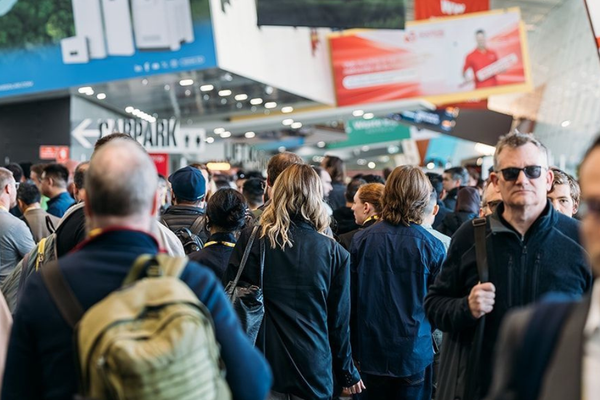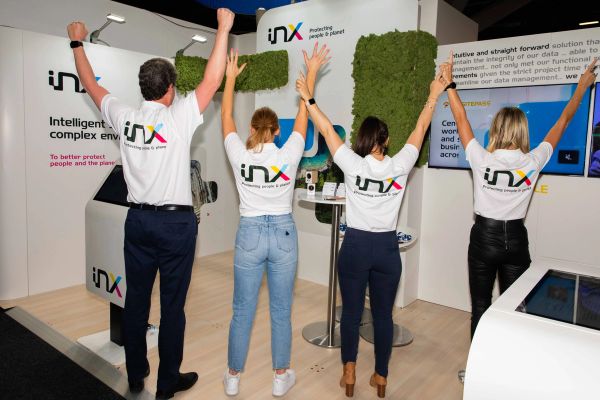If your sales and marketing teams are pulling in opposite directions, every exhibition will feel like a checkbox exercise. For every step forward, there will be two backwards and no matter how impressive your stand looks, it won’t make up for the hard slog to get it across the line.
Over the years, I’ve seen this exact scenario play out on repeat. A client comes to us excited about making a splash at their next trade show so we come up with a bold, objective-driven strategy that nails their key message, positions them as the go-to experts while driving tangible business outcomes. The plan is sound. The design is stunning. But the execution? Dead on arrival.
Why? Because the sales and marketing were on totally different pages. The whole proposal takes time and doesn’t get lift off. The design and plan that gets put forward is mediocre because it’s delivered with half the information.
How do I get team buy-in for my exhibit design?
Don’t for a second think that I’m suggesting the sales team don’t matter. The sales team will always have valuable frontline insights because they are talking to customers daily, but they only see it through their lens. They can’t dictate how marketing should market because they are missing a good portion of the puzzle.
A great exhibit strategy comes to life when you connect the dots between those insights, brand goals and audience engagement. It’s up to marketing (and your trusted trade show strategist) to interpret how best to communicate with your audience so it is the most impactful and aligned with your goals.
The solution isn’t to sideline sales. It’s to involve them early. When the sales team contribute in the planning stage, they’re more likely to back the strategy instead of resisting it. Of course, this needs to be managed properly and getting a strategist like myself to facilitate the process is ideal because my experience can spot the bottlenecks and align everyone before the issues arise.
Your exhibit looks good, but doesn’t convert
Clients often ask us, “Why do exhibition strategies fail even when the stand looks great?” The answer: because it lacked data-driven alignment.
Planning an exhibition without sales input is like baking without a recipe. You might end up with something edible, but unless you bake it with the precise quantities it won’t be exceptional.
Sales data tells us:
- Who’s worth targeting
- What conversations convert
- Which prospects are already in play
When we integrate this data into your strategy we are fine tuning every design element, engagement activity and team interaction so it is engineered for impact. The result is an experience that “just works”.
What happens when sales don’t back your trade show strategy?
From the outside, many exhibition stands look fine. They can be on-brand, polished, professional. You might not look like idiots to your customers and prospects, but “fine” doesn’t bring you results.
You could be doing giveaways and have a booth heaving with visitors but without a strategic backbone you won’t position the brand for real growth, you won’t get bigger budgets and the team will slowly lose faith in trade shows because “they don’t work”.
It’s why we push back against the “that’s how we’ve always done it” mindset. Our answer: evolve your approach, or your results won’t either.
How to get leadership to try a new trade show approach
For conservative businesses who have a good handle on trade shows, change can be hard.
My answer to this is always: run one event with clear KPIs and measure the difference. The data speaks louder than you ever can.
If you can take that first step on one event, you will start having conversations about data, not anyone’s gut feel. From there, perspectives will start to shift. There’s no finger pointing because you’re dealing with facts. Our clients who take this leap often tell us, “We wish we’d done this sooner.”
Advice from a Change Management Consultant
Linda Benny, Founder of Enable Change Partners, says she see’s this unfolding in workplaces all the time. She shared some advice with me that I knew deep down, but recognised often gets neglected:
“True alignment doesn’t happen by accident. It’s the result of intentional engagement, clear communication, and giving people the chance to co-create the path forward. In other words, if you want your exhibition strategy to succeed, you need to manage the change, not just the project.”
Her practical tips to consider:
- Engage early and often. Don’t wait until the design is signed off to bring sales into the room. Involve them at the vision stage, when their insights can shape the strategy. Early engagement builds ownership.
- Translate strategy into clarity. It’s not enough for leadership or marketing to have a big-picture plan. Sales teams need the “so what?” what does this mean for their conversations, their customers, their day-to-day role at the event?
- Create advocates, not passengers. When people feel heard and see their input reflected in the strategy, they shift from resisting change to championing it. That advocacy drives both energy on the stand and credibility with prospects.
- Sustain beyond the event. A trade show isn’t the finish line, it’s a milestone. The lessons, insights, and relationships built need to be embedded back into the business to fuel ongoing growth.
Change doesn’t have to always feel 'hard'
It’s true, for businesses who’ve “always done it this way,” the idea of shaking things up can feel daunting. But change doesn’t have to be a burden. When you bring people on the journey early, even the most conservative teams often surprise themselves with how quickly they adapt.
“We’ve seen it time and again, once leaders and teams get a taste of what’s possible with a fresh approach, the energy shifts from reluctance to excitement. Suddenly, it’s not about letting go of the old way, it’s about unlocking better results. And that’s a change people can get behind.” – Linda Benny, Enable Change Partners
The OSCAR Alignment Advantage
Bottom line is if you want different outcomes, you need a different approach. Old habits and internal politics can drag down businesses and prevent them from using trade shows to drive business growth. The truth is, alignment isn’t just about getting everyone on the same page, it’s about building commitment that lasts beyond one event. When you combine a smart strategy with real adoption, you don’t just get a booth that looks good, you get results that endure. The good news, is that there’s a process to making all of this happen. It’s why OSCAR exists! The cute name is also an acronym for the journey our clients go on (Objective > Strategy > Creative > Action > Results). We’ve built our process to solve the buy-in problem before it kills your ROI. Using our OSCAR process we align leadership, sales, and marketing around shared goals before we
design a single wall panel. The right strategy is what turns your attendance from a line item in the budget to a smart investment.
So, what’s your biggest hurdle to getting everyone on the same page?



